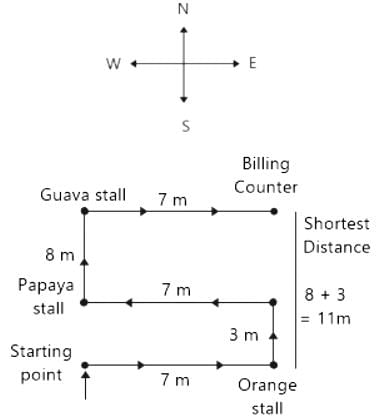SSC MTS Mock Test - 5 - SSC MTS / SSC GD MCQ
30 Questions MCQ Test - SSC MTS Mock Test - 5
If 8 boys and 12 women can do a piece of work in 25 days, in how many days can the work bedone by 6 boys and 11 women working together?
Sum of eight consecutive odd numbers is 656. Average of four consecutive even numbers is 87. What is the sum of the largest even number and largest odd number?
A vendor sells 50 percent of apples he had and throws away 20 percent of the remainder. Next day he sells 60 percent of the remainder and throws away the rest. What percent of his apples does the vendor throw?
Glass A is filled with 2/3rd of wine and the remaining portion is filled with water. Similarly, glass B of same size is filled with 4/7th of wine and remaining with water. The contents of the two glasses are poured in a tumbler and mixed. The ratio of water to wine in the tumbler is:
Consider a cylinder of height h cm and radius r = 2/π cm, as shown in the figure (not drawn to scale). A string of a certain length, when bound on its cylindrical surface starting at point A and ending at point B, gives a maximum of n turns (in other words, the string's length is the minimum length required to wind n turns). What is the vertical spacing in cm between the two consecutive turns?

In this following question, four words have been given, out of which three are alike in some manner and the fourth one is different. Choose out the odd one out.
The rows and columns of the left matrix have been labelled as 5, 6, 7, 8, 9 and C, D, E, F, G, whereas those of the right matrix are 0, 1, 2, 3, 4 and H, I, J, K, L. Find the correct row-column pairs out of these matrices that decode to the word - HFYO
Direction : Study the following question carefully and choose the right answer.
Q: In a code TIGER is written as SHFDQ, how shall HORSE be written in that code?
Directions: Study the following information carefully and answer the given questions.
Virat goes to Supermarket store to buy fruits. He enters the market, turns to his right, walks 7m and takes oranges. Then, he turns to his left, walks 3m and takes Peach. Again, he turns to his left, which is towards west, walks 7m and takes Papayas. Again, he turns to his right and looks at guavas, which 8m away from him. He takes guavas and moves to his right, walks 7m and stops at the counter for billing.
Q. What is the shortest distance between the Orange stall and the Billing Counter?
The Lahore Session of the Indian National Congress (1929) is very important in history because
- The Congress passed a resolution demanding complete independence.
- The rift between the extremists and moderates was resolved in that session.
- A resolution was passed rejecting the two-nation theory in that session.
Which of the statements given above is/are correct?
How many runs did Sachin Tendulkar was scored in his ODI debut?
Which one of the following glands produces the growth hormone (somatotrophin)?
The mountain range which divides the North and the South India is–
Which authority recommends the principles gov erring the grantsin-aid of the revenues of the States out of the Consolidated Fund of India?
Which of the following is/are the objectives of the Debt Management Strategy of Government of India?
1. To mobilise borrowings at low cost while keeping the risks at prudent levels.
2. To maintain a stable and sustainable debt structure so as to ensure financial stability.
3. Development of a well-functioning domestic bond market.
Select the correct answer using the code given below.
What is the theme of the 7th edition of the India Mobile Congress (IMC 2023)?
Which naval ship participated in the training exercise 'Operation Southern Readiness 2023'?
In the following questions four alternatives are given for the idiom/phrase italicised and underlined in the sentence. Choose the alternative which best expresses the meaning of idiom/phrase.
Q. He is out and out a reactionary.
In the following questions four alternatives are given for the idiom/phrase italicised and underlined in the sentence. Choose the alternative which best expresses the meaning of idiom/phrase.
Q. I did not mind what he was saying, he was only through his hat.
Today most businessmen are very worried. To begin with, they are not used to competition.In the past they sold whatever ...(1)... produced at whatever prices they chose. But ...(2)... increasing competition, customers began to ...(3)... and choose. Imports suddenly became ...(4)... available and that too at cheaper ...(5)...
What will come in Option Four?
Today most businessmen are very worried. To begin with, they are not used to competition.In the past they sold whatever ...(1)... produced at whatever prices they chose. But ...(2)... increasing competition, customers began to ...(3)... and choose. Imports suddenly became ...(4)... available and that too at cheaper ...(5)...
What will come in Option Five?
Which of the following is the FIRST sentence after rearrangement?
Direction: In each of the questions given below, a sentence is given with two blanks. From the given options, choose the one that gives the correct combination of words that fit in the blanks.
In a _______________ to the exchanges, the company said it intends to _______________ the date of submission of the Q1 results.
The active voice sentence "The teacher will grade the papers tomorrow" can be changed to passive voice as:
Direction: Read the following passage carefully and answer the question that follows.
After a worrying pre-monsoon phase between March and May, when rainfall was scarce, the current robust season in most parts of coastal, western and central India augurs well for the entire economy. Aided apparently by beneficial conditions in the Indian Ocean, very heavy rainfall has been recorded, notably in Maharashtra, Gujarat, Rajasthan, the northeastern States, Karnataka, the Konkan coast, hilly districts of Kerala and Tamil Nadu. This pattern may extend into Chhattisgarh, Odisha, Bengal and other eastern regions. A normal Indian Summer Monsoon is bountiful overall, but as last year’s flooding in Kerala, and the Chennai catastrophe of 2015 showed, there can be a terrible cost in terms of lives and property lost, and people displaced. Distressing scenes of death and destruction are again being witnessed. Even in a rain-shadow region such as Coimbatore in Tamil Nadu, the collapse of a railway parcel office after a downpour has led to avoidable deaths. What this underscores is the need to prepare for the rainy season with harvesting measures, as advocated by the Centre’s Jal Shakti Abhiyan, and a safety audit of structures, particularly those used by the official agencies. In drafting their management plans, States must be aware of the scientific consensus: that future rain spells may be short, often unpredictable and very heavy influenced by a changing climate. They need to invest in reliable infrastructure to mitigate the impact of flooding and avert disasters that could have global consequences in an integrated economy.
The long-term trends for flood impact in India have been one of declining loss of lives and cattle since the decadal high of 1971-80, but rising absolute economic losses, though not as a share of GDP. It is important, therefore, to increase resilience through planning, especially in cities and towns which are expanding steadily. Orderly urban development is critical for sustainability, as the mega flood disasters in Mumbai and Chennai witnessed in this century make clear. It is worth pointing out that the response of State governments to the imperative is tardy and even indifferent. They are hesitant to act against encroachment of lake catchments, river courses and floodplains. The extreme distress in Chennai, for instance, has not persuaded the State government against allowing structures such as a police station being constructed on a lake bed, after reclassification of land. Granting such permissions is an abdication of responsibility and a violation of National Disaster Management Authority Guidelines to prevent urban flooding. As a nation that is set to become the most populous in less than a decade, India must address its crippling cycles of drought and flood with redoubled vigour. Scientific hydrology, coupled with the traditional wisdom of saving water through large innovative structures, will mitigate floods and help communities prosper.
Q. Which among the following is correct regarding the pattern of rainfall in the future as declared by the scientific community?
Direction: Read the following passage carefully and answer the question that follows.
After a worrying pre-monsoon phase between March and May, when rainfall was scarce, the current robust season in most parts of coastal, western and central India augurs well for the entire economy. Aided apparently by beneficial conditions in the Indian Ocean, very heavy rainfall has been recorded, notably in Maharashtra, Gujarat, Rajasthan, the northeastern States, Karnataka, the Konkan coast, hilly districts of Kerala and Tamil Nadu. This pattern may extend into Chhattisgarh, Odisha, Bengal and other eastern regions. A normal Indian Summer Monsoon is bountiful overall, but as last year’s flooding in Kerala, and the Chennai catastrophe of 2015 showed, there can be a terrible cost in terms of lives and property lost, and people displaced. Distressing scenes of death and destruction are again being witnessed. Even in a rain-shadow region such as Coimbatore in Tamil Nadu, the collapse of a railway parcel office after a downpour has led to avoidable deaths. What this underscores is the need to prepare for the rainy season with harvesting measures, as advocated by the Centre’s Jal Shakti Abhiyan, and a safety audit of structures, particularly those used by the official agencies. In drafting their management plans, States must be aware of the scientific consensus: that future rain spells may be short, often unpredictable and very heavy influenced by a changing climate. They need to invest in reliable infrastructure to mitigate the impact of flooding and avert disasters that could have global consequences in an integrated economy.
The long-term trends for flood impact in India have been one of declining loss of lives and cattle since the decadal high of 1971-80, but rising absolute economic losses, though not as a share of GDP. It is important, therefore, to increase resilience through planning, especially in cities and towns which are expanding steadily. Orderly urban development is critical for sustainability, as the mega flood disasters in Mumbai and Chennai witnessed in this century make clear. It is worth pointing out that the response of State governments to the imperative is tardy and even indifferent. They are hesitant to act against encroachment of lake catchments, river courses and floodplains. The extreme distress in Chennai, for instance, has not persuaded the State government against allowing structures such as a police station being constructed on a lake bed, after reclassification of land. Granting such permissions is an abdication of responsibility and a violation of National Disaster Management Authority Guidelines to prevent urban flooding. As a nation that is set to become the most populous in less than a decade, India must address its crippling cycles of drought and flood with redoubled vigour. Scientific hydrology, coupled with the traditional wisdom of saving water through large innovative structures, will mitigate floods and help communities prosper.
Q. Which among the following is correct regarding the response of the states to the need to tackle flood situations?















